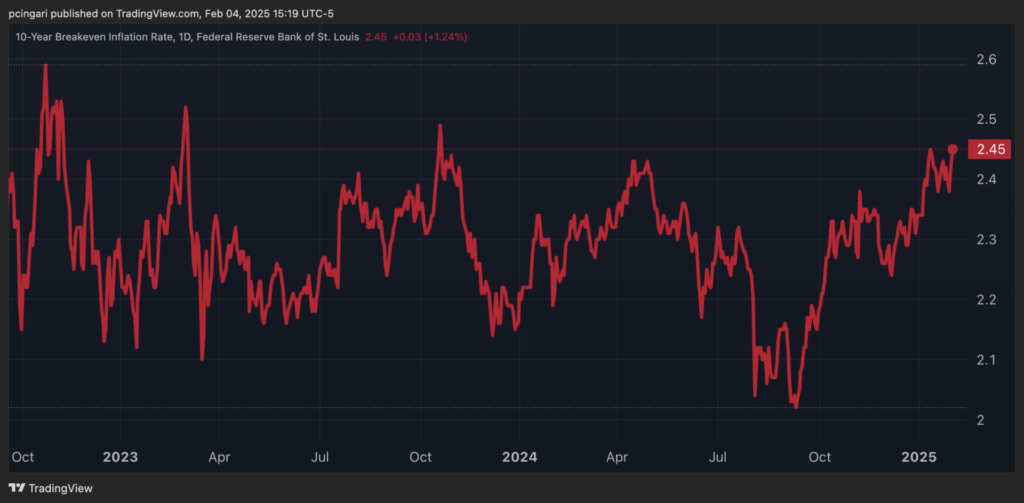Zinger Key Points
- Domestic manufacturers could capitalize on reduced competition by raising prices further, Comerica Bank's Bill Adams says.
- Yes, inflation remains below the extreme levels seen in 2022, market sentiment suggests it's going to get worse.
- Feel unsure about the market’s next move? Copy trade alerts from Matt Maley—a Wall Street veteran who consistently finds profits in volatile markets. Claim your 7-day free trial now.
A key market-based gauge of long-term U.S. inflation expectations has surged to its highest level since October 2023, signaling mounting investor concerns over more persistent price pressures for the economy.
The shift in market sentiment, fueled by trade policy uncertainty under the Donald Trump administration, is already influencing Federal Reserve rate expectations and bond market positioning.
Inflation Fears Resurface In Bond Markets
The U.S. 10-year breakeven inflation rate—a measure derived from the spread between nominal Treasury yields and Treasury Inflation-Protected Securities—climbed to 2.45% as of Monday's close, according to TradingView data.
This implies that investors now predict annual inflation to average 2.45% over the next decade.
For bondholders, this threshold is critical.
If annual inflation exceeds an average of 2.45% for the next 10 years, TIP bonds—which are broadly tracked by the iShares TIPS Bond ETF TIP—offer a superior hedge, as they provide a 2.06% real yield plus inflation compensation.
By contrast, nominal 10-year Treasuries, represented by the U.S. 10-Year Treasury Note ETF UTEN, yield 4.51% but provide no inflation protection.
Chart: 10-Year Breakeven Rate Hits 2.45%, Highest Since October 2023

Tariff Uncertainty
The inflation debate has intensified amid speculation over potential tariff increases.
According to Bill Adams, chief economist at Comerica Bank, rising tariffs on imported goods would contribute to higher consumer prices as importers pass costs onto customers, while domestic manufacturers could capitalize on reduced competition by raising prices further.
“While the exact timing and size of higher tariffs is anyone's guess, Comerica's forecast assumes that tariffs do increase on American purchases of foreign goods this year,” Adams said Tuesday.
“The bear flattening of the yield curve seen on Monday indicates the bond market views tariffs as a short-term inflation risk and a potential problem for growth further out,” said Kristian Kerr, head of macro strategy for LPL Financial.
On Monday, China responded to Trump's 10% import tariff, by implementing countermeasures, including export restrictions on key minerals to the U.S. and new tariffs on American energy products.
China raised tariffs by 10%-15% on select U.S. imports such as coal, liquefied natural gas, crude oil, agricultural machinery, and vehicles.
Goldman Sachs estimates that a broad 10% tariff hike could add roughly 1 percentage point to core personal consumption expenditures—the Federal Reserve's preferred inflation gauge.
"The boost to U.S. consumer prices would likely be enough to further slow Federal Reserve policy rate cuts," Brian Coulton, chief economist at Fitch Ratings, wrote in a note.
Betting Markets See Higher Inflation In 2025
Speculators on the CFTC-regulated betting platform Kalshi have significantly raised their wagers on inflation exceeding expectations in 2025.
Market-implied odds indicate a 58% chance that the annual Consumer Price Index will hit at least 4% in one or more months this year—the highest probability recorded since Kalshi launched the market in November 2024.
For January 2025 alone, it’s more likely than not that the CPI inflation exceeds 2.9%.
While inflation remains below the extreme levels seen in 2022, market sentiment suggests that the battle against rising prices is far from over.
With the breakeven rate climbing, tariff risks looming, and betting markets pricing in higher prices, investors may be bracing for a longer period of economic uncertainty than previously anticipated.
Read Now:
Image: Shutterstock
Edge Rankings
Price Trend
© 2025 Benzinga.com. Benzinga does not provide investment advice. All rights reserved.
Trade confidently with insights and alerts from analyst ratings, free reports and breaking news that affects the stocks you care about.